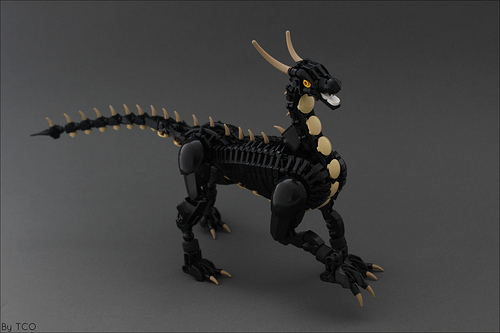I used to think that a dragon without wings was simply a lizard, but I wouldn’t dare say that to the face of this wingless dragon built by Leonid An. His name is Glaurung the Fierce, and with his athletic, lean build and large claws, this dragon looks like it could easily rip any opponent to shreds, especially a heckling human who dares mock his lack of wings.
What I love about this dragon in particular is the way the builder has used repetition throughout the body, neck, and tail to achieve a very clean organic figure. For example, the robot arm piece is used at least twenty times, laced through flex tube to give both the subtle and more drastic curves the body of the dragon required. The 2×2 round tan boat studs are used as armor plating from the top of the neck of the dragon, all the way down underneath the belly to the tail, making for a wonderfully consistent aesthetic.

Glaurung is the father of all dragons in middle earth. So it’s awesome to see him in lego form.
Chinese dragons are universally wingless. Japanese dragons go through a metamorphosis at some point, which is the only time they appear with wings. But they’re dragons, and wings aren’t really a big part of flying when you’ve got off-the-chart levels of magic at your disposal.
I would love to see what that dragon would look like if it had wings.
I love the seamless transition from system to constraction parts at the legs.
The dragon is he archetypal representation of the eternal enemy that must be overcome. No one questions why they hoard gold or hold maidens captive, but it’s obvious when one puts them in the context of a story – the result of overcoming an encounter with the ultimate predator/enemy/obstacle is societal riches and popularity with the opposite gender. Wings represent the spiritual/transcendent aspect of the terrible opponent, so it’s interesting that the depiction of eastern Dragons don’t recognise this aspect.
My impression was that Asian dragons were mostly benevolent, with maleficent dragons reserved for European folklore.